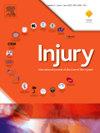Role of trauma center level in the outcome of severely injured geriatric patients
IF 2.2
3区 医学
Q3 CRITICAL CARE MEDICINE
Injury-International Journal of the Care of the Injured
Pub Date : 2025-01-31
DOI:10.1016/j.injury.2025.112201
引用次数: 0
Abstract
Background
According to the nationally imposed standard of care in the Netherlands, severely injured patients should be brought to a Level-1 trauma center for primary treatment. If not, they are considered to be undertriaged. This study aimed to determine the incidence of undertriage among severely injured geriatric patients and to evaluate the relation between hospital-undertriage and patient outcomes in elderly.
Methods
This retrospective cohort study used anonymized data from the regional trauma registry of 1,431 patients aged ≥70 years with an Injury Severity Score ≥16 that were admitted to hospitals within the Trauma Region West-Netherlands between 2015 and 2022. Poor patient outcome was defined as in-hospital mortality or as a Glasgow Outcome Scale (GOS) score ≤3 at hospital discharge. The association between hospital level and poor outcomes was analyzed using multivariable logistic regression analysis with adjustment for confounders after multiple imputation of missing values.
Results
Seventeen percent of the severely injured geriatric patients were primarily transported to a Level-2/3 hospital. Female patients, older patients, and patients that had suffered a low-energy fall were most likely to be undertriaged. The adjusted odds ratio's for in-hospital mortality and GOS score ≤3 in Level-1 versus Level-2/3 hospitals were 1.26 (95 % confidence interval, 0.83–1.93; p = 0.28) and 0.81 (95 % confidence interval, 0.57–1.15; p = 0.24), respectively.
Conclusion
Undertriaged severely injured geriatric patients did not have a higher risk for poor outcomes. Level-2/3 hospitals seem to present a safe alternative for the treatment of these patients.
求助全文
约1分钟内获得全文
求助全文
来源期刊
CiteScore
4.00
自引率
8.00%
发文量
699
审稿时长
96 days
期刊介绍:
Injury was founded in 1969 and is an international journal dealing with all aspects of trauma care and accident surgery. Our primary aim is to facilitate the exchange of ideas, techniques and information among all members of the trauma team.

 求助内容:
求助内容: 应助结果提醒方式:
应助结果提醒方式:


